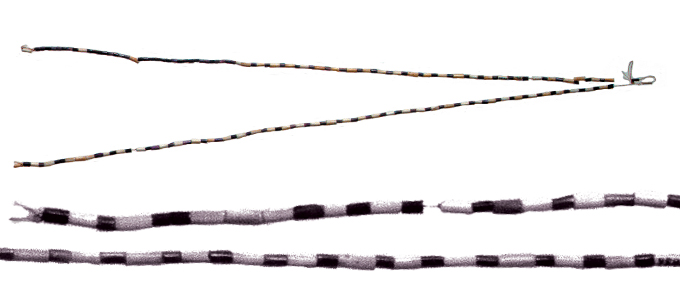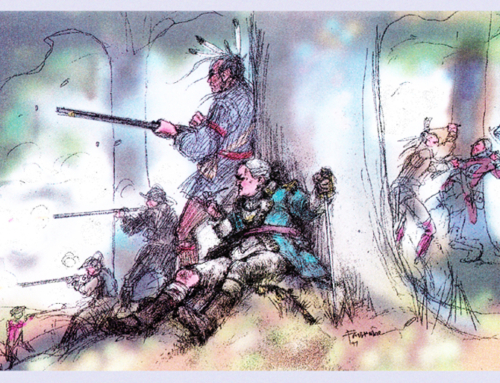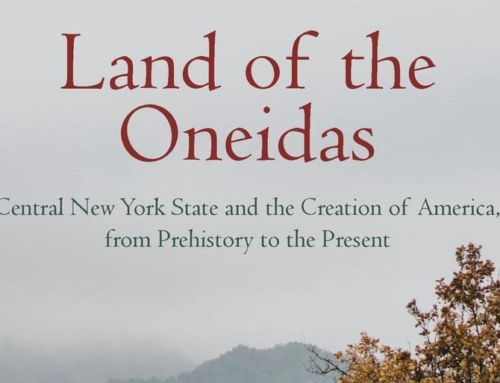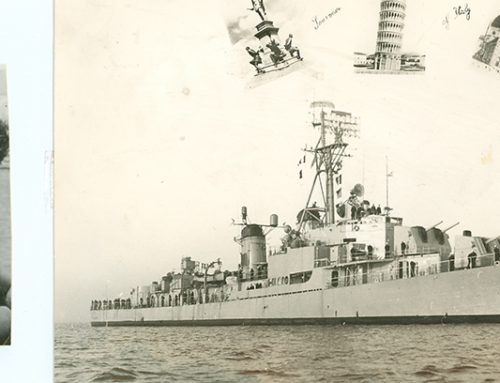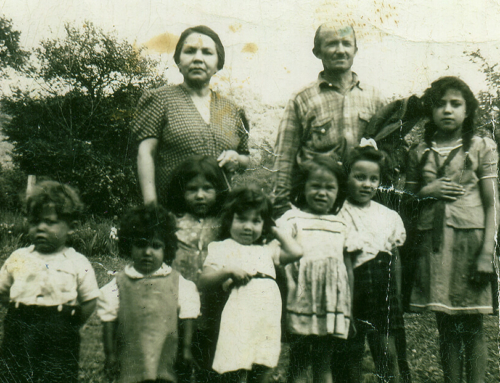Several years ago the Oneida Indian Nation reacquired a priceless heirloom from the American Museum of Natural History, New York City – a wampum string (pictured). Once held by Chief Chrisjohn Beechtree (1804-1869) it is an important title wampum representing the office of a leader of the Turtle Clan.
Under the terms of the federal law called the Native American Graves Protection and Repatriation Act (NAG-PRA), the American Museum of Natural History repatriated this wampum string in 1999 as an object of cultural patrimony – something collectively owned, something of continuing importance to the Oneida people, and something that could never have been rightfully sold by one person.
This was the first repatriation request received by the American Museum of Natural History.
The String
During the late summer of 1907, Mark Harrington, a “picker” – or buyer of Indian artifacts for collectors and museums, passed through Oneida N.Y. looking for valuable old Oneida objects. He found one at a house near the site of the current Ray Elm Children and Elders Center, a wampum string purchased for $5.84 from Oneida Daniel Webster.
Harrington listed this object in his notebook as “Oni go’l ha.” This Oneida word for wampum was translated by Chief William Rockwell as “meaning or referring to a mind of knowledge or credentials.”
A few days later, Harrington heard more about this string serving as credentials. Onondaga Thomas LaForte told him the string has been held by Chrisjohn Beechtree, and that it represented “the Chieftanship of the Turtle Clan – Oneida.” Because Harrington wrote this down, we know that Haudenosaunee people then recognized this string as a title wampum.
According to oral tradition the Peacemaker is said to have appointed nine Oneida chiefs to the Haudenosaunee Confederacy, three titles residing in and passed on within each clan. A title wampum validates and symbolizes one of these ancient League sachemships. Presumably LaForte was telling Harrington that this string stood for one of the three offices of chief belonging to the Oneida Turtle Clan since time immemorial.
The String’s Journey
Mark Harrington’s Oneida string ended up in the American Museum of Natural History in New York City, where it remained for more than 90 years.
Prior to Harrington’s visit, the string remained in the same Oneida house for some 50 years. Daniel Webster, the seller of the string, was the son-in-law of Chrisjohn Beechtree, having married Beechtree’s daughter, Hannah Beechtree. Dan Webster and his wife lived in Beechtree’s home after Beechtree’s death. That house was located on the west side of Route 46, across from the old Windfall cemetery.
Chrisjohn Beechtree and Dan Webster lived in the Windfall Community, one of two locales near the City of Oneida that Oneidas held onto locally after the loss of nearly all of their traditional territory to the state of New York. Then lying within the Town of Lenox in Madison County, the Windfall Community was the western tract left to Oneidas after the last New York treaty of 1842.
The only documented guardian of the wampum string was Chrisjohn (or Christian) Beechtree, born around Oneida in 1804 or 1805. His grandson, Louie Stout, later testified that Chrisjohn Beechtree was “one of the leading chiefs of the Oneidas” (Oneida Kansas Claim #829, 1901). The earliest reference to Beechtree as a chief in the Windfall Community dates to 1851 (Pomroy Jones, Annals and Recollections of Oneida County, 1851, page 870).
Why Sell the String?
Daniel Webster parted with the wampum string under extreme and heartbreaking circumstances.
First, he let the string go only when he was very close to death and perhaps on his deathbed. Harrington purchased the string between June and October of 1907; Webster passed away in early October 1907.
Second, Dan Webster and other Oneidas remaining in the New York homeland endured a bleak existence. Moving testimony about conditions at the Windfall Community comes from William Rockwell and “Doc Bates.” Chief Rockwell, born on the Windfall Community in 1870, was a contemporary and neighbor of Daniel Webster. Dr. Erl Bates, of the Indian Extension, New York State College of Agriculture, Ithaca, was frequently quoted as an authority on Indian affairs throughout the first half of the century.
We became poverty stricken – Wah oong woong doon don nae
Our minds are saddened – Wah oong awa nee goong lux.
Many of my people died with a broken heart. Pains of sorrow and grief took them to their graves. I was old enough to remember the kindly old men and women, how gently they would lay their hands on our heads, because they loved us so. And when they would turn away, their eyes were filled with tears. Some would cry with sympathy for us and future generations who were to lose the human freedom god gave the red-skinned children. The men also with a look of great concern would talk of the changes taking place. As they would look out over a great stretch, not a tree left standing. No place for the animals that furnished out food and clothing supply, that required wooded land to live. Not only that, the land, as far as they could (see), was no longer theirs and ours.
— Rockwell Papers: Box II, Collection 4, File 20 and other locations
The White People in Madison Co. (County) were desirous of ridding the Oneidas and crosses on deeds for a bottle of whisky, attempts to forclose (sic.) met resistance. Six free passes to Buffalo Bill Wild West at Utica brought the Oneidas to the show and while there twenty-eight deputy sheriffs threw the furniture of the Oneidas on the road. Thus began at dawn the Last Indian War in the East (1891). Some Oneidas recaptured their homes and some retreated to Onondaga.
— Erl Bates, undated issue (c. 1960) of Cornell Arrow – Six Nations Agricultural and Homemakers Society newsletter, “Dates on Oneidas,” Oneida Indian Files at Onondaga Historical Association, Syracuse.
Obituaries, References
- The 1860 census of the Town of Lenox in Madison County, which includes the Windfall Community, lists Christian Beechtree, age 56, wife Polly, age 53, and four children, including the eldest daughter, Hannah, age 22.
- The 1865 census of Oneida Indians in the same area indicates that Chrisjohn Beechtree, age 60, had become a widower (his wife died in 1863). In 1865, Chrisjohn Beechtree’s household did not include Hannah, who had married. She is now listed as Hannah Webster, age 26, below the name of her husband, Daniel Webster, age 35. Chrisjohn Beechtree died Dec. 3, 1869.
- Hannah and her husband, Daniel Webster, lived in Chrisjohn Beechtree’s house after Beechtree’s death in 1869. An 1875 map of the Windfall shows that “D. Webster” lived in the house formerly identified as that of “C. Beechtree” on the 1859 map. Daniel Webster lived until October 1907.
ONEIDA POST
April 25, 1903
DIED IN THE FIRST WARD
On Wednesday night of heart disease at her house I the first ward occurred the death of Hannah, wife of David Webster, aged 70 years. Mrs. Webster was the daughter of the last of her father’s family. Besides her husband she leaves one son, Elija. Mrs. Webster was born and had always lived in the vicinity of the place where she had died. Funeral services were held at the Mission church at two o’clock yesterday afternoon. Rev. J.C. Crowther officiating.
DEMOCRATIC UNION
October 5, 1907
DANIEL WEBSTER
Daniel Webster, the oldest Indian residing on the Oneida Reservation, died at his home Saturday afternoon at 4 o’clock. He was born and had always resided here. As near as can be learned, he was 88 years of age. He was a familiar figure on the streets of Oneida, his stalwart and upright figure attracting attention. He was respected and esteemed. He was an inveterate hunter and trapper and the room in which he died was hung his heavy rifle and numerous traps. His wife, a sister of Chief Beechtree, died three years ago. He leaves one brother, Henry of Green Bay, Wis. several nieces and nephews and three grand children. The funeral was held Tuesday afternoon at 2 o’clock. Rev. Mr. De Vol officiating. Interment was made in the Indian cemetery.


